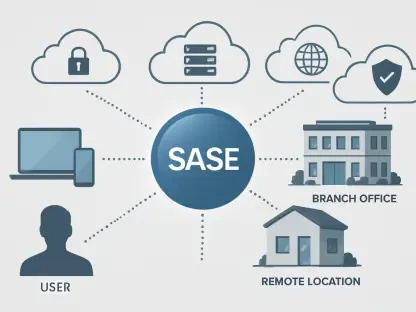In an era where artificial intelligence (AI) has woven itself into the fabric of enterprise technology, the cybersecurity landscape is undergoing a profound transformation that demands urgent attention from organizations worldwide. With a staggering 78% of organizations integrating AI into at least one business function, as reported by a recent McKinsey & Company survey, the potential for innovation is matched by an equally significant rise in digital risks. AI’s dual role as both a powerful ally for defenders and a formidable weapon for attackers has created a complex battleground where traditional security measures often fall short. From crafting sophisticated attacks to identifying vulnerabilities at lightning speed, AI is redefining the rules of engagement in cyberspace. This exploration delves into the intricate ways AI is altering the nature of cyber threats while highlighting the evolving strategies required to safeguard sensitive data and systems against an increasingly intelligent adversary.
The Dual Nature of AI in Cybersecurity
AI as a Tool for Innovation and Risk
The adoption of AI across industries has surged, promising unprecedented efficiency and productivity gains for enterprises eager to stay competitive. However, this technological leap comes with a steep price in terms of cybersecurity exposure. As AI systems streamline operations—from automating customer service to optimizing supply chains—they also expand the attack surface for malicious actors. A Lenovo report from September reveals a sobering reality: only 31% of IT leaders express moderate confidence in their ability to fend off AI-driven threats, with a mere 10% feeling highly assured. This pervasive unease stems from the recognition that AI can be harnessed to create highly targeted attacks, such as phishing campaigns that mimic legitimate communications with uncanny precision. The challenge lies in balancing the benefits of AI integration with the heightened risks it introduces, pushing organizations to rethink how they protect critical assets in an environment where innovation and vulnerability are two sides of the same coin.
Beyond the operational advantages, the darker implications of AI’s widespread use are becoming impossible to ignore. Cybercriminals are exploiting AI to develop tools that evade detection by traditional antivirus software and firewalls, often outpacing the defensive capabilities of many organizations. The same algorithms that enhance business analytics can be repurposed to analyze network weaknesses or automate large-scale attacks with minimal human intervention. This growing concern among IT leaders—61% of whom view offensive AI as an escalating risk—highlights a critical need for updated security protocols. The rapid democratization of AI technology means that even less-skilled attackers can access powerful tools, amplifying the threat landscape. As enterprises continue to embed AI into their core functions, the pressing question remains how to harness its potential without inadvertently providing adversaries with the means to exploit systemic vulnerabilities.
Vulnerabilities in AI Platforms
The trust placed in AI platforms, often seen as cutting-edge solutions, can be shattered by hidden flaws that expose organizations to significant danger. A striking example is the “ShadowLeak” vulnerability discovered in ChatGPT by Radware, which enabled cybercriminals to extract email data through malicious HTML code embedded in messages. Although OpenAI resolved the issue by August, the incident revealed a disturbing truth: even the most widely used AI tools can serve as unintended gateways for data theft. This breach exploited the email integration feature, turning a trusted platform into a liability for unsuspecting users. Such vulnerabilities underscore the fragility of reliance on AI systems without adequate safeguards, as millions of businesses and individuals depend on these tools for daily operations. The fallout from such incidents can erode confidence and necessitate a deeper examination of how AI platforms are secured against exploitation.
Addressing these vulnerabilities requires more than quick fixes; it demands a comprehensive, multi-layered approach to defense that anticipates potential weaknesses. The ShadowLeak flaw is not an isolated case but a symptom of broader challenges in ensuring the security of AI-driven systems. As these platforms handle increasingly sensitive data, the stakes for protecting them grow exponentially. Security teams must prioritize rigorous testing and continuous monitoring to identify flaws before they are exploited, rather than reacting after a breach occurs. Additionally, fostering transparency between AI developers and end-users can help build trust while ensuring that patches and updates are deployed swiftly. The broader implication is clear: without robust defenses, the very tools designed to enhance productivity can become conduits for catastrophic data loss, forcing organizations to adopt a more skeptical stance toward the security of AI technologies they integrate into their workflows.
Evolving Threats and Defensive Challenges
The Gap in Vulnerability Detection and Remediation
AI’s ability to revolutionize cybersecurity includes its capacity to detect software vulnerabilities with remarkable speed, outstripping human analysts in identifying potential weaknesses. Tools like XBOW, praised by former U.S. cybersecurity official Rob Joyce, exemplify how AI can scan vast codebases to pinpoint flaws that might otherwise go unnoticed. However, this technological advantage is undermined by a critical shortcoming: the pace of detection often far exceeds the ability to implement effective remediation. Legacy systems, in particular, pose a significant hurdle, as they may lack support for timely patches or require extensive overhauls to address identified issues. This lag creates a dangerous window of opportunity for attackers who can exploit known vulnerabilities before defenses are updated. The disparity between spotting a flaw and fixing it represents a systemic risk that could lead to severe breaches if not addressed with urgency and strategic planning.
The consequences of this detection-remediation gap are not merely theoretical but have real-world implications for organizational security. When vulnerabilities are identified faster than they can be patched, organizations are left exposed to threats that range from data theft to full-scale system compromises. This challenge is compounded by the sheer volume of flaws that AI tools can uncover, overwhelming IT teams already stretched thin by other priorities. Attackers, often using AI themselves, can weaponize these delays, targeting unpatched systems with precision and speed. To mitigate this risk, a shift toward automated patch management and prioritization of critical fixes is essential. Collaboration between software vendors and enterprises must also improve to ensure that updates are not only developed quickly but also deployed without disrupting operations. Bridging this gap is a cornerstone of modern cybersecurity, as failure to do so risks turning AI’s diagnostic prowess into a liability rather than an asset.
Insider Threats and AI Integration
As AI becomes more deeply embedded in corporate environments, the potential for insider threats to exploit these systems is emerging as a pressing concern. Employees using public AI tools without authorization can inadvertently expose sensitive data, bypassing established security protocols. Beyond human error, the integration of AI agents—designed to automate tasks and access proprietary information—introduces another layer of risk. If compromised, these agents can become powerful tools for malicious activities like ransomware or extortion. The Salesloft Drift breach serves as a stark reminder of how insider threats amplified by AI can lead to devastating consequences, as attackers leveraged internal access to wreak havoc. This evolving danger highlights the need for stringent controls over how AI is deployed and monitored within organizational boundaries to prevent internal exploitation.
Mitigating insider threats tied to AI requires a multifaceted strategy that prioritizes both technology and policy. Robust access controls and continuous monitoring are vital to ensure that AI agents operate within defined parameters and cannot be repurposed for unauthorized actions. Equally important is employee education, as many insider risks stem from a lack of awareness about the dangers of unsanctioned AI tool usage. Organizations must establish clear guidelines on acceptable use while implementing systems to detect and flag anomalies in AI behavior. Real-world incidents underscore that internal vulnerabilities can be as damaging as external attacks, necessitating a cultural shift toward vigilance. By fostering a security-first mindset and pairing it with advanced technical safeguards, enterprises can reduce the likelihood of AI becoming a conduit for insider-driven breaches, ensuring that its benefits are not overshadowed by preventable risks.
Reinventing Cybersecurity for an AI-Driven World
Adapting Zero Trust Architectures
The surge of AI-enhanced threats, such as deepfakes and credential theft, has exposed the limitations of traditional security frameworks, necessitating a reinvention of defensive strategies. Zero trust architectures, built on the principle of “never trust, always verify,” are gaining renewed importance as a countermeasure to these sophisticated attacks. AI-driven exploits often target identity-based vulnerabilities, using convincing impersonations to bypass authentication. Enhancing zero trust principles with stricter identity verification and granular network segmentation is critical, especially as AI agents gain access to sensitive data within organizations. This approach ensures that even if one layer of defense is breached, additional barriers prevent lateral movement by attackers. Adapting these architectures to address AI-specific risks is not just a recommendation but a necessity in an era where trust can no longer be assumed.
Implementing an AI-ready zero trust model requires a commitment to continuous validation and advanced technologies that keep pace with evolving threats. Multi-factor authentication, behavioral analytics, and real-time monitoring are essential components that can detect anomalies indicative of AI-generated attacks, such as deepfake-enabled social engineering. Furthermore, segmenting networks to limit access based on role and necessity minimizes the potential impact of a breach, even if credentials are compromised. The integration of AI into corporate systems demands that zero trust evolve beyond static policies to dynamic, adaptive frameworks capable of responding to the speed of AI-driven exploits. By prioritizing identity protection and reducing implicit trust, organizations can build a resilient defense against threats that exploit the very technologies meant to advance business goals, ensuring that security keeps step with innovation.
Shifting to a Proactive Security Posture
The rapid evolution of AI in both offensive and defensive capacities has rendered reactive cybersecurity approaches obsolete, urging a shift toward proactive strategies that anticipate rather than respond to threats. AI-enabled attacks unfold at a pace that traditional incident response cannot match, often exploiting vulnerabilities before they are even recognized as risks. Building a forward-thinking security posture involves leveraging predictive analytics and threat intelligence to identify potential attack vectors in advance. This means not only using AI to detect flaws but also simulating attacker behavior to uncover weaknesses before they are exploited. Such a dynamic approach ensures that defenses are not merely catching up but staying ahead, adapting to the relentless innovation of cyber adversaries who wield AI with increasing sophistication.
A proactive stance also necessitates investment in scalable solutions that can evolve alongside AI-driven threats over the coming years. Automation plays a pivotal role here, enabling rapid response to identified risks and reducing human error in high-pressure scenarios. Collaboration across industries to share threat intelligence can further enhance this approach, creating a collective defense against common AI-enabled tactics. Moreover, embedding security into the development lifecycle of AI systems ensures that risks are mitigated from the outset rather than addressed as afterthoughts. The lesson from recent breaches and vulnerabilities is clear: waiting for an attack to occur before strengthening defenses is no longer viable. By anticipating the next wave of AI-powered threats and adapting strategies accordingly, the cybersecurity community can transform a landscape of escalating risks into one of managed, calculated resilience.









